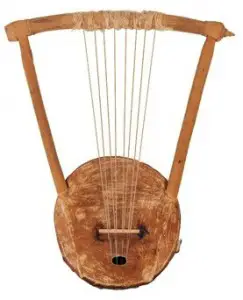In Ancient Egypt, music was not only an important part of ceremonies and festivals but also a part of daily life. For instance, farmers would sing while sowing and harvesting crops. Large groups of flutes or stringed Egyptian Instruments were known to entertain at royal parties.
Musical Instruments
Music found its way into many contexts in Egypt: temples, palaces, workshops, farms, battlefields and the tomb. Music was an integral part of religious worship in ancient Egypt. In Egyptian Instruments were usually identified with the primary deities such as Hathor, Isis and Sekhmet and these deities would often be shown playing musical instruments such as the sistrum, drum, and merit.

The Ancient Egyptians loved music and talented musicians were in great demand. Music provided a focal point at banquets and religious ceremonies. The musicians of the Old Kingdom were traditionally men but, as the ages passed, this trend had completely reversed by the advent of the New Kingdom and the majority of musicians were women.
Classification of Egyptian Instruments
All Egyptian instruments can be classified into one or more of the following categories: idiophones, membranophones, aero phones and chordophones. Many of the ancient musical instruments have evolved into many modern day instruments used in orchestras today. Ancient Egyptian membranophones include tambourines and drums of various shapes and sizes.
An idiophone is any musical instrument able to produce sounds by rigorous self-vibration. These instruments were played by temple priestesses who led Pharaohs, funerals and temple priests in ritual ceremonies. Egyptian aero phones are the flute, trumpet, pipes and double reed pipes. Chordophones are string instruments whose sound is produced by the vibration of the strings.
Harps were favorite instruments during the New Kingdom and were shown in the hands of professional female musicians performing alone or in ensembles with singers, wind instruments, and rattles. Harps varied greatly in form, size and the number of their strings.
The New Kingdom lute consisted of a small oblong wooden sounding box, flat on both sides, with six or eight holes, and a long neck, often decorated with ribbons, from which two to four strings were strung. It was played with a plectrum or bare fingers.
Wind instruments consisted of flutes called Ugab, Trumpets, Shofar, double pipes, Trumpets etc. Flutes, the oldest had a sharp wedge resting just outside of the lips. Trumpets were made of silver and bronze, with mouthpieces of gold or silver. Cymbals, Bells, Castanets, Hand-held drums form the group of Percussion instruments.
In the second century BCE, the Alexandrian Ctesibios invented the hydraulic organ which used water pressure to deliver air to the organ-pipes.